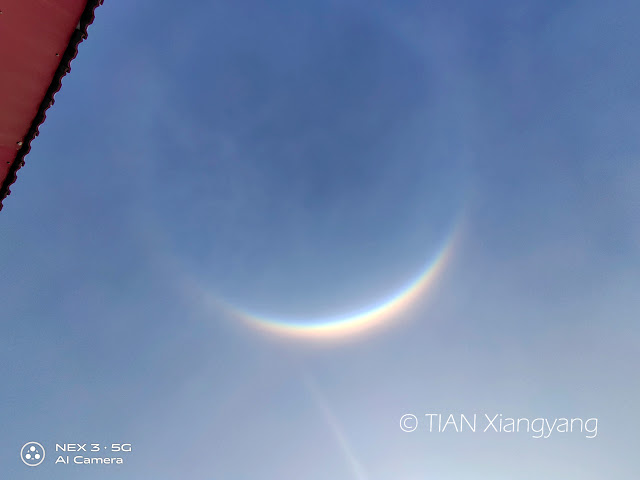On the morning of Feb 14 2020, a blanket of natural, high quality diamond dust lingered above Siziwang Qi (Dorbod Banner), Inner Mongolia for about two hours (later reports suggest the display lasted the whole day), treating the locals with a jaw-dropping plate display.
Crystal density and quality were so high that parhelia, circumzenithal arc, parhelic circle, 120° parhelia and even Liljequist parhelia all look insanely bright in photos and videos. Such intensity undoubtedly made multi-scattering possible. 44° parhelia showed up very well in most locations despite the relatively high sun elevation. In the following photo, the sun had risen to 20° and the 44° parhelia were still there.
The true highlight of the display, however, lurked near the zenith. The circumzenithtal arc appeared not only bright, but also as a full circle, even to unaided eyes. The Kern arc, finally!
While most observers’ attention were drawn to the low hanging gems near the horizon, some did bother to look up and documented Kern arc’s grand debut in China. These two untouched handphone photos below speak volumes about the arc’s top rate quality.
 |
| © ZHENG Dan, shown with permission |
 |
| © TIAN Xiangyang, shown with permission |
The following videos will give you an idea of how crazy the scene was:
https://m.weibo.cn/5299394320/4471803969617073
https://m.weibo.cn/5703217900/4473449294440181
https://m.weibo.cn/6624168505/4472005455908200
https://m.weibo.cn/5703217900/4473449294440181
https://m.weibo.cn/6624168505/4472005455908200
Once the initial excitements died down, we began to wonder about the Kern arc’s true origin in this display. The arc appeared rather smooth and uniform all around and somewhat broader than the circumzenithal arc. Could this broad, diffuse appearance be attributed to multi-scattering?
With the help of Zhang Jiajie’s simulation program (https://github.com/LoveDaisy/ice_halo_sim/tree/master/cpp), we found out that multi-scattering is capable of noticeably enhancing the Kern arc for both regular and triangular plate crystals. Also note how the gaps in the regular plate Kern arc get filled and smoothened out by multi-scattering.
 |
| Simulation by ZHANG Jiajie, sun elevation at 13° |
 |
| Simulation by ZHANG Jiajie, sun elevation at 13° |
The multi-scattering enhancements above have at least two components:
- A secondary circumzenithal arc created by parhelia, parhelic circle and 120° parhelia
- A secondary parhelic circle created by the original, single-scattered circumzenithal arc
 |
| Simulation by ZHANG Jiajie, sun elevation at 13°, semi-triangular plate crystals with c/a = 0.3 are used |
These rings, when integrated, can get brighter than the Kern arc in simulations, especially when crystals are thin. So theoretically it’s possible for them to overwhelm the Kern and become the main player. In reality though, co-existence might be the more reasonable answer.
Back to the display itself, Marko Riikonen commented in our email exchange that this display is almost a clone of the legendary 1970 Saskatoon display (http://www.thehalovault.blogspot.com/2011/01/the-saskatoon-halo-display.html), in which the 44° parhelia were first photographed. According to Marko, visual sightings of the Kern arc were reported by the photographers but veracity of these reports has been much debated until recent years. Now that we have a repeat event with undeniable Kern arc presence, the Saskatoon chapter could probably be closed.
Best regards,
Jia Hao

